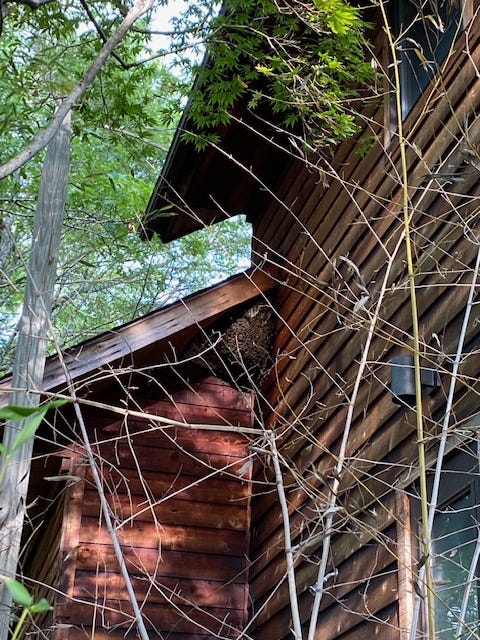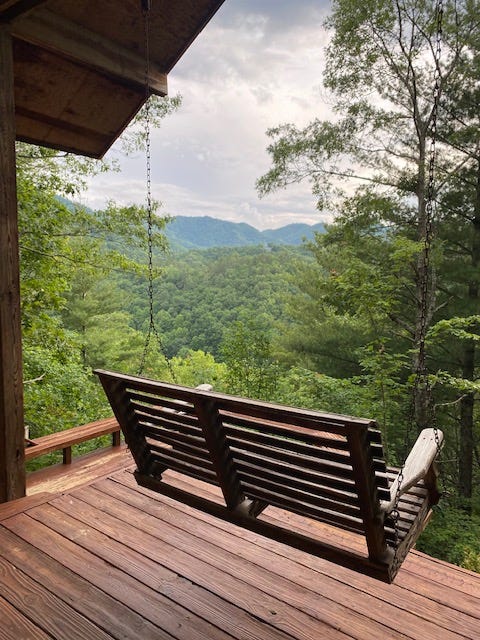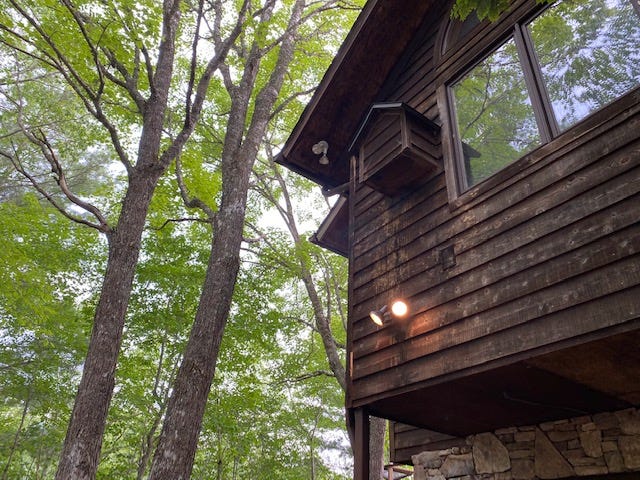What to consider if you need honey bees cut out of your home
Sometimes a swarm of bees likes your home just as much as you do, but you’ll need to evict them.
February kicks off swarm season in my corner of North Carolina. Swarms are a sign of a healthy colony as it’s how a colony reproduces. When a hive swarms, the queen and about half the worker bees leave with her. They collect on a nearby structure or tree, and then real estate scout bees come back to the group and pitch a spot with a water view, a penthouse in the hollow of a hickory branch, or the south-facing cozy nook between your siding and your Sheetrock that a scout found through your soffit.
Last summer I got a call from someone in an extremely rural part of the Western North Carolina mountains near the Nantahala Outdoor Center. She was desperate for someone to remove honey bees from her home. The colony had loved her home so much that they had swarmed, and the daughter colony was building comb under the eave of the opposite side of her house.
I went to check it out to see if they were really honey bees and not wasps, and also to see if I could remove the bees by myself. Bee removals fall into a few categories. A cutout means that someone needs to physically cut open a wall and remove the colony. Some bee removal services have special honey bee vacuums, then they’ll cut the comb out afterwards, and then repairs can happen. A trap out means that you can set up a bait hive and an entrance cone, which prevents bees from entering after they leave. They eventually have no choice but to tell the queen to come out and join them in the bait hive. (I’ve spoken with a few experienced bee removal folks and some say that the queen doesn’t always leave. Sometimes the queen and some workers refuse to abandon their brood—baby bees.)
I’ve never done a cutout or trap out before. I learned several things when I visited the home with the two bee colonies. One, some people live in REALLY remote places. I had a feeling I would lose cell service, so I had sent my husband the address and texted him when I left. I went by myself (and had my puppy with me). I turned on a dirt road that followed a river through what I think is best described as a Jurassic Park-esque valley of kudzu. I see a lot of the invasive vine throughout the mountains, but had never seen it choke out a landscape like in this space. When I turned on the homeowner’s driveway, she had mentioned that I would pass a house or two before dead-ending at her home. That shared driveway was one-way, steep, more than a mile long, and had a freshly chain-sawed tree that had fallen across the driveway. I don’t want to imagine what it’s like driving up there at night. Or in the rain. Or at night in the rain. Getting the bees would be easier than any of those scenarios.
The other thing I learned was that there’s a payoff to living on a remote mountaintop. The view was wild. Short-range and long-range mountains as far as you can see, and no other homes, utility lines, or Walgreens to be found. I honestly spent just as much time looking out at the landscape as I did checking the colonies.
The biggest learnings I had came after I had low-geared my way down the mountain and arrived back home to call the owner. Even though I shared all of the following concerns and proposed a solution for both colonies, she directed me to do something else. I didn’t think a homeowner would make such an irresponsible decision, and I learned otherwise. I declined the project and attempted to connect her with other bee removal services. Here are the considerations and concerns I presented to her:
Mold. After I learned that the colony living in her home had resided there for 10 years(!!), I highly encouraged the owner to secure a professional bee removal service for a complete cut out. Imagine how much comb the colony had built over that time within her walls. The colony entrance was in a seam along the kitchen stove vent, so any cut out work would be around the complex utility lines, kitchen appliances, and cabinetry. I advised her to seek a licensed contractor to manage the repairs, and to ideally guide the bee removal team if the removal folks weren’t licensed contractors themselves. The owner declined this suggestion and instead wanted me to do a trap out—just remove the bees and she would leave the colony’s comb in the house. I explained that leaving the comb meant not just leaving wax, but also any pollen, nectar and honey, and baby bees—all of which have a moisture content associated with them. The moisture in her walls could create mold—and may have already started to mold in some parts if there are areas of the colony the bees don’t have adequate coverage.
Pests. Having an established colony in your home can also attract pests. Mice are known to make nests in honey bee hives, so why not choose a colony with an entire house as their hive? Since the owner only wanted a trap out, I explained that the remaining comb and honey would attract mice, ants, and other critters looking to feed on dead baby bees and honey. Small hive beetles, which I severely struggle with in my mountain apiary, will eat EVERYTHING in a colony, including the wax. Small hive beetles can smell and fly to wax miles away, so her home could become a beetle magnet.
More bees. One of the things swarms are attracted to is old comb. They might take up residence where another colony had died out. The old comb is already in place as the start of a foundation, and the previous colony may have left some food behind. (Think of it as either buying raw land or buying a fully-framed house.) Since the owner wanted the trap out only, even closing off the entrance might not prevent colonies from being attracted to her home. They would still smell the old comb and resources in her home, so they might find another hole in her siding, or under the eave into her attic. Take this homeowner’s current situation: She had one colony she didn’t remove expediently and it multiplied. She now has 2 colonies living in and on her home.
If you or someone you know has a colony of bees living in their home, hopefully by now you know the most important things: Hire a reputable bee removal service and a licensed contractor for any repairs, and don’t let the colony live there for 10 years—get it removed as soon as you learn about it.






